
I’m beginning to notice that rich and powerful men build their homes with wide, expansive views of lawns and rivers. Witness Washington at Mt. Vernon, Pinchot at Grey Towers (no river but sweeping views across the valley) and now the Rockefeller family at their estate outside Tarrytown, New York, Kykuit.
Kykuit means “lookout” or “hill” in Dutch, a fitting name describing the home of four generations of Rockefellers. From the heights of the back porch, one luxuriates in sweeping panoramic views of the Hudson River at its widest point curving along the Palisades lining the far shore. Eighty-seven of John D. Rockefeller, Sr.’s original 4,000 acres now belong to the National Trust, and the family has donated another 1,000 acres for the Rockefeller State Park Preserve. The rest of the property is used by the current Rockefellers, so when you pass through the gates of Kykuit, you are truly
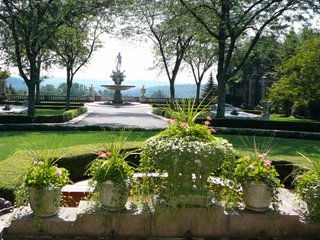 entering their world, not only as it was but also as it is.
entering their world, not only as it was but also as it is.You must go to Kykuit on a tour; because it really is their home, no private cars are allowed through the gates. We began at Phillipsburg Manor where all tours originate. We chose the 2 ¼ hour Kykuit House and Inner Garden Tour, one of several available. This one is recommended for first time visitors, and I recommend it to you although there is 3 hour Grand Tour, and perhaps, because there is so much to see and so many views to savor, that is the way to go. I think it’s up to your tolerance and stamina. While we waited for the tour to be called, we enjoyed a cup of coffee in the café, a nice leisurely beginning to the day. Then we were comfortably bussed from the Visitor Center to Kykuit.
The house was built by John D. Rockefeller, Sr., founder of Standard Oil and a man who saw philanthropy as a business—give money with a purpose and the object will reap the rewards of smart investing. He conceived the idea of endowments, for instance, so that an organization could have continuing income from its monetary investments. One of his early gifts was to a Baptist college holding classes in the basement of a church. The aim was to educate newly emancipated females. Rockefeller Sr. felt the college should have its own building. Eventually this college became Spelman College, named for his wife’s family who was part of the anti-slavery movement.
The original house was very modest. Rockefeller, a devout Baptist, did not entertain, dance, drink, smoke or play cards. His son, John D. Rockefeller, Jr., a little more liberal, married Abby Aldrich, much more worldly, and from her came his love of art.
 He collected classical art, and he oversaw the construction of the current house. The eagle at the top of the house over the main doorway represents the family’s pride in America, and the figures of the gods, Demeter and Apollo, represent the family’s love of nature and culture. Jr.’s mostly classical art collection remains, and the love of art was instilled by both father and mother in their son, Nelson, once governor of New York. He had more modern tastes, and the works he added to the home represent artists such as Picasso, Calder, Brancusi, and Jean Arp. Yet the designers he hired for the home managed to allow a flow from the old to the new, and the blend works seamlessly throughout the house. The house remains as Nelson Rockefeller left it when he died, some pieces enclosed in plexiglas because his was the first generation where children lived in the house.
He collected classical art, and he oversaw the construction of the current house. The eagle at the top of the house over the main doorway represents the family’s pride in America, and the figures of the gods, Demeter and Apollo, represent the family’s love of nature and culture. Jr.’s mostly classical art collection remains, and the love of art was instilled by both father and mother in their son, Nelson, once governor of New York. He had more modern tastes, and the works he added to the home represent artists such as Picasso, Calder, Brancusi, and Jean Arp. Yet the designers he hired for the home managed to allow a flow from the old to the new, and the blend works seamlessly throughout the house. The house remains as Nelson Rockefeller left it when he died, some pieces enclosed in plexiglas because his was the first generation where children lived in the house.The gardens are magnificent. Ironically, the gardens cost more to design and build than the house. The landscape architect, William Welles Bosworth, spent ten years working
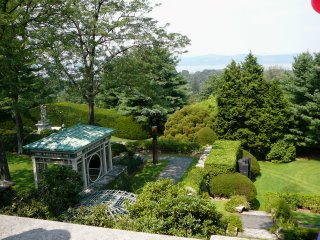 on the gardens and statuary. Breathtaking is an understatement. Everything is in place; everything creates dramatic effect. Classical sculpture appears in fountains and statuary, but so does modern art. Each piece is juxtaposed perfectly. Each creates a feeling of serenity and beauty. You MUST go yourself in order to appreciate it.
on the gardens and statuary. Breathtaking is an understatement. Everything is in place; everything creates dramatic effect. Classical sculpture appears in fountains and statuary, but so does modern art. Each piece is juxtaposed perfectly. Each creates a feeling of serenity and beauty. You MUST go yourself in order to appreciate it.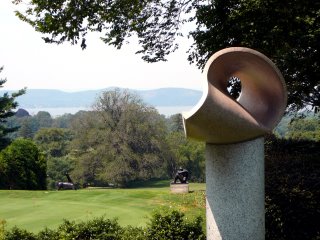
We also visited the Coach Barn with its remarkable collection of coaches, sleighs, and pony carts. The only thing missing is Cinderella’s pumpkin! There is even a surrey with the fringe on top! Attached to the ceiling is a contraption that allowed coaches and horses to be washed when they returned from their jaunts. This is the precursor, no doubt, of today’s car wash. Let’s not forget the cars. From a Ford predating the Model T right up to what I might consider a “classic,” the Coach Barn contained them all. This, as the house, is a museum although it is tough to admit I am older than some of the museum pieces. And I am sure they are better preserved!
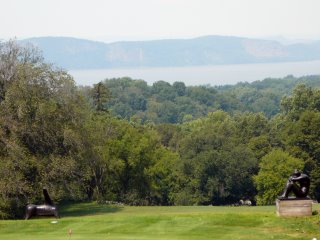 Kykuit is one of a network of six historic sites in the Hudson Valley. Each one is unique and historically intriguing. It’s a good idea to make return trips and see them all. BTW, the Inner House and Garden Tour is wheelchair accessible.
Kykuit is one of a network of six historic sites in the Hudson Valley. Each one is unique and historically intriguing. It’s a good idea to make return trips and see them all. BTW, the Inner House and Garden Tour is wheelchair accessible.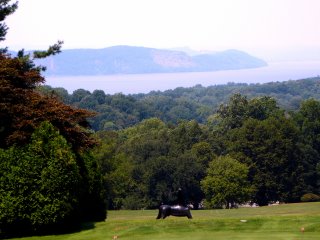
1 comment:
That really was quite a room. I liked the idea that John D. Jr. went to his father John D. Sr. and asked to borrow a million dollars to buy some art! And I think today's kids are nervy...
Post a Comment